
Festival
of contemporary choreography in Indian dance
- Dr. Sunil
Kothari
e-mail: sunilkothari1933@gmail.com
February 21,
2009
The International
Festival of Contemporary Choreography in Indian Dance began on January
23, 2009 at Betty Oliphant Theatre, in Canada's National Ballet School
auditorium. The important event opened with Menaka Thakkar Dance Company's
presentation of SHAKTI, an excerpt from Chandralekha's classic feminist
prism choreographic work 'SRI' (created in 1991). The full length version
of SRI was performed by the Chandralekha Dance Company in Toronto in February
1993 during the very first New Directions in Indian Dance Festival and
a conference. The present remount was a tribute to Chandralekha. During
2008, Shaji John, Chandralekha's principal artiste and Kalaripayattu artiste,
visited Canada for a month and taught Kalaripayattu to the dancers of Menaka's
company. This movement form was vital physical training and input to Chandra's
dance choreography. From London, Geetha Sridhar, Chandra's lead dancer
from the earlier group who had performed in 'Sri,' visited Toronto twice
to teach the movement as per Chandra's choreography.
This is for
the first time that Chandra's choreographic work has been performed by
other dancers. The amount of work which has gone behind for consultation
with Chandra's long time associate for her major productions, and lights
designer Sadanand Menon indeed has been remarkable. The dancers of Menaka
Thakkar's Dance Company including guest dancers Amanda Geroy and Branda
Leary performed with confidence with Geetha Sridhar's supervision and participation
as a lead dancer. The energy level and Chandra's understanding of the body,
the movements as reflected in her original work were approximated, though
it cannot be grasped completely, as it does require long practice and gestation
period. However, with Geetha's special choreographic reconstruction, the
result was more than satisfying. Sadanand's lighting added to the production
values and some of us who have seen this work of Chandra's many times in
India and abroad were pleased that such an initiative was taken by Menaka
Thakkar Dance Company and Sudha Khandwani's Kalanidhi Fine Arts of Canada.
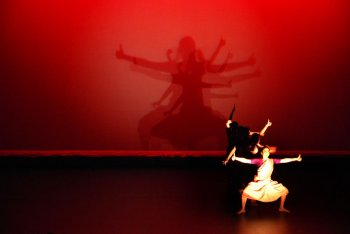 Photo: Tamara Chatterjee
Photo: Tamara Chatterjee
|
 Second from right is Geetha Sridhar
Photo: Tamara Chatterjee
Second from right is Geetha Sridhar
Photo: Tamara Chatterjee
|
I would like to
quote from Chandralekha's choreographer's note, made available by Sadanand:
"Choreographed in three segments, 'Sri' is a non-narrative chronicle of
'Women's Question' from an Indian perspective." Originally choreographed
in 1991, it was performed nationally and internationally over dozen times
till 1993. In the original production, Chandralekha herself performs an
unusual eight minute long 'Prologue.'
"Taking inspiration
from her research into visual and textual evidences from the material history
of the sub-continent, Chandra emphatically asserts the 'primacy' of women.
The work was made soon after the choreographer spent three years researching,
conceptualizing and producing 'Stree,' a massive exhibition on Indian women,
for the Festival of India, Moscow. Her story begins from 'pre-history,'
from 'female-centred'
civilizations
and 'origin' concepts, which gave us concepts of empowerment, concepts
of 'Shakti' and 'Sapta-Matrikas,' who preside over birth, life and the
fertility of soil and the people. Woman here is primal to creation, a pulsating
ancestral power, the original vulva from whom all creation springs. 'Sri'
also pays homage to concepts like 'Purusha' and 'Prakriti' which acknowledge
the equality and uniqueness of the male and female, when united."
Rustom Bharucha,
the author of a book on Chandralekha, in one of his reviews (1991) has
observed that in 'Sri,' Chandra as a choreographer traced different layers
of significance in dominant concepts of Indian women. It is not a pragmatic
work, an explicit denunciation of women's oppression. The reality on which
Chandra weaves the most intelligent, non-decorative patterns of movement,
relates to the process of women's consciousness. In it, we are made to
confront continuous dynamic fears, hesitations, gropings, grouping, breaks,
reassembling, all these elements moving towards the affirmation of a collective
feminine strength composed of individual energies.
The segment
which was performed on 23rd and again on 29th January reflected this aspect.
The drag walk, the breaking of the spine, the mopping of the floor, in
a sitting position, the coming together, and when regaining power, using
the simple Bharatanatyam movements, one wondered how Chandra fathomed such
power in these movements! The finale with dashabhuja, the ten armed 'Shakti'
with exquisite lighting by Sadanand, the dancers with arms spread marching
forward has left an indelible impression. The performance and VV Subramaniam's
original violin score evoked the magic of Chandra's work.
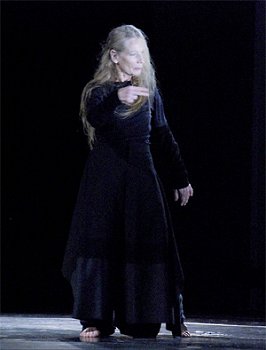 Susanne
Linke
Susanne
Linke
|
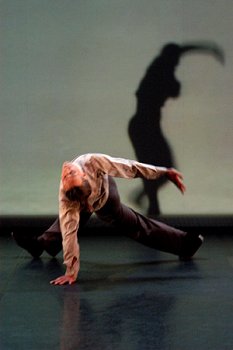 Urs Dietrich
Urs Dietrich
|
As special tribute
to Chandralekha, German dancer Susanne Linke and another male dancer Urs
Dietrich were invited to present their choreographic works. Urs Dietrich
is an award winning modern dancer. His choreographic work 'Herz Kammern
–Heart Chambers' was fascinating. The opening movement reminded one of
Chandra's 'Sharira' work, though Urs had never seen it. The lightness with
which his body moved on the floor, the way the feet moved and the manner
in which he rotated on the floor like a lotus swaying over water - ah,
the imaginative choreography was exquisite. The work as per the program
note, gave entry points into his attempts at depicting reality and dream,
humour and despair, between man and woman. It raised questions: Where
is the soul, where are the emotions? Where is the blood? Even if one did
not follow it, the experience of watching him dance was extremely pleasant.
The awareness of the yoga movements was evident.
Susanne Linke
and Chandra shared over the years, a deep bond and an elemental sensibility,
right from the year 1984, when they met in Mumbai during the East West
Dance Encounter. Their friendship grew over the years and Susanne's few
visits to India and also workshops, continuous conversations and correspondence,
sharing stage in 1993 in New Delhi, Chandra's visits to Germany, and till
her passing away, they had remained in touch with each other. As a tribute
to Chandra, she was specially invited to present her new work in the festival.
She has choreographed 'Kaikou-Yin' (Transmigration) which speaks to the
animalistic element of human beings and the human side of animals. Dressed
in black, Susanne crawled on the floor and moved so lightly, one rarely
saw her figure, the flow was so powerful. She was light, flying, becoming
almost invisible, one could not define what she was, but she was
like a life force - one wondered from which space she came and where did
she go? In barely twenty minutes she danced to Gustav Mahler's fifth symphony
- Adagietto. Choreography, lights design and costume were all by her. Having
known her since 1984 and often seen her work in India and abroad, I was
deeply moved. Never once it occurred to any one that she was in her late
sixties. Such internalization of feelings and dance appeared remarkable.
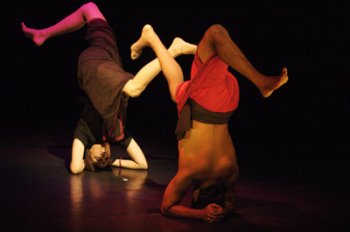 Tishani
Doshi and Shaji John
Tishani
Doshi and Shaji John
|
Next day 'Sharira'
was presented with the live music by Dhrupad singers Gundecha brothers
with Akhilesh on pakhavaj, and two artists on tanpura, featuring Shaji
John and Tishani Doshi, and lighting by Sadanand. I was lucky to attend
two rehearsals, of which, one was with lighting at the theatre. Even though
I have been close to Chandra and had the privilege to be with her during
the creation of many of her works including 'Sharira,' re-visiting this
presentation, after an interval of four years (I last saw it at Bhopal
when she received Kalidas Samman award), this staging startled me with
its multi-layered dimensions. During my several illustrated talks in India
and abroad at many forums, I have screened excerpts from the DVD of 'Sharira'
made by Ein Lall, and have listened to Chandra's voice, speaking about
the secrets of the body, the geometry of the body, the triangles, and when
she speaks of the sexuality in the body, the sensuality in the body, the
spirituality in the body and all without any divisions, 'Sharira' as performed
by Shaji John and Tishani Doshi, left me speechless.
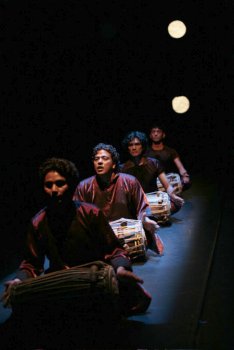 Timeless
Photo:
Anja Buetler
Timeless
Photo:
Anja Buetler
|
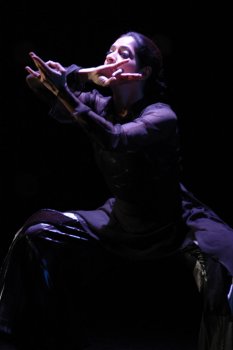 Timeless-Aditi
Photo:
Tasveer
Timeless-Aditi
Photo:
Tasveer
|
The second week
of performances was scheduled from January the 28th at the renamed Fleck
Dance Theatre, at Harbourfront Centre. Formerly called PDT, or Premiere
Dance Theatre, the lovely blue interiors witnessed 'Timeless' by Aditi
Mangaldas and her company.
In 'Timeless,'
Aditi deals with the theme of Time. In her choreographer's note, she says:
'Timeless is not an answer, not an opinion, nor a single perspective; it
is a question, in fact many questions, an attempt to see, to feel, to experience,
to hear, to touch the intangible, wonder filled thing called Timeless;
maybe one sees it as time related to space, maybe one hears it as an eternal
flow, maybe one perceives it totally still...'
She has posed
many questions: Is time reversible? Is there time or many times? Is time
still? Is time parallel? Does time flow? Can we hold time past and time
present? Is time flexible? Is time cyclical? Does time trip? Does time
end? Several questions. Far too many questions for one evening and one
work. An attempt to articulate them in a non-verbal art of dance, using
time tested Kathak technique, mastered over years, integrating martial
art like Kalaripayattu and yoga vocabularies, without ruptures, using classical
Hindustani music, vocals, instrumental, also non- Indian instruments, collaborations
with vocalists like Shubha Mudgal, percussionist Anish Pradhan and several
others, musicians, appearing on stage, sitting, in a row, playing pakhavaj,
reciting mnemonic syllables, dancers using vachikabhinaya, several strategies,
drawing upon Kathak resources... the list goes on and on. Aditi challenged
audiences and critics and sometimes confused them too.
In the opening
sequence 'Is time reversible?' Aditi moves and other three female dancers
are still, they sway slowly, right and left, up and down, energizing things,
attempting reversal element through abstraction. Then she moves to question
of time or many times, indicating separate time orders, Kathak movements
employed indicate it obliquely. Using poem of Javed Akhtar that mentions
the optical illusion we experience, when travelling by train, seeing trees
moving though rooted in one place, dancers dancing slowly creating an illusion,
Aditi has cleverly arranged sitting on floor two musicians, facing each
other which suggests Time which is still and which is moving.
There are images
which one recalls long after the performance is over. Four male, two musicians,
two dancers, sit in a row, vertical position, in a line, playing
pakhavaj, two female dancers perform facing each other, separated by
the boundary created by the percussionists, for an attempt at creating
impression of is time parallel - through abstraction, not one to one relation,
and it succeeds in its representation. Paran- amads are recited by the
percussionists, echoes, sound creating barrier, how is time perceived,
a suggestion is there. This is a most strong visual in terms of choreography.
When Shubha Mudgal's singing fills the auditorium with song 'Piyaki akor....'
the union indicated in sequence of time past and future in time present,
Aditi in a solo, deconstructs a hasta mudra suggesting 'a timeless present.'
It leaves an opaque impression - such abstraction is sometimes difficult
to articulate.
I had not read
the program notes and noted impressions, that later on, I compared the
notes with her, since Aditi had stayed back. Often such festivals and conferences
provide such rare opportunities for an interaction. That helped to have
a dialogue. When she showed the final sequence - does time end? - the dancers
move forward in silence making slight sound of their movement, walking
towards the audience frontally; it suggested the end of the program.
There were too many climaxes to this ambitious piece that somehow did not
gel for that particular evening's performance. But Aditi's own superb dancing
and excellent technique held the evening together. With the shift
in the thematic content from sheer technical virtuosity of Kathak, contemporary
choreography in Indian dance has moved towards abstraction, and a cerebral
high, taking audiences to different experiential levels.
From Montreal,
Roger Sinha presented 'Quebasian Rhapsody,' word play on Quebec and Asian,
with his partner Magdalena Nowecka. He has acknowledged Natasha Bakht as
a co-choreographer for using some excerpts from his other work 'Loha.'
He is known in India for his choreographic work 'Burning Skin' presented
in September 1993. Roger has come a long way since then and has to his
credit several works. By a coincidence, during my visit to Montreal in
October last year, I had attended one of his rehearsals of the present
work with Aditi and Mamata Niyogi Nakra. It has developed further exploring
dual vocabulary of contemporary dance and Bharatanatyam.
Roger has attempted
to integrate contact improvisation, elements of martial arts and Bharatanatyam
with his own personal fast style, though his athletic build often contrasts
with fluid movements of Bharatanatyam by the female partner. Using Natyarambham
position with extended arms horizontally, they together execute forcefully
teermanam, the concluding movement which is very distinctive of Bharatanatyam.
The duo ties stainless steel bells on shin and arms. The stamping and dancing
create distinct sound texture. After a while the bells are removed and
both dance together, also separately, facing each other and come together,
covering space, running all over the stage. Using Gayatri mantra 'Om bhu
...' the finale is built up raising the female partner heavenward.
However, often the movements appeared laboured, weak and contrived with
the use of a remixed "Gayatri Mantra" serving to irritate some of the Indians
in the audience.
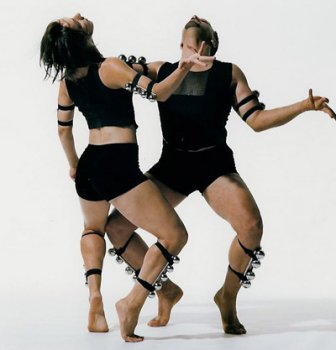 Sinha
Danse
Sinha
Danse
|
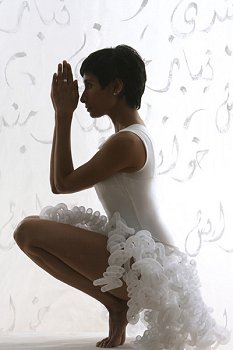 Natasha
Bakht
Natasha
Bakht
|
Two other performances
which stood out for sheer brilliance and innovations were of Natasha Bakht
and Ipsita Nova Bhattacharya. Both are of Indian origin, born and brought
up in Canada. They started learning from Menaka Thakkar from a very young
age, mastered the classical Bharatanatyam technique and now have branched
out on their own in different directions working towards contemporary choreography,
creating their own works. Natasha studied and worked with Menaka for more
than twenty years. She also worked with choreographers like Yvonne Coutts,
Joan Phillips, Wayne McGregor to name a few, including three seasons with
Shobana Jeysingh's Dance Company in London, appearing also in the Kalanidhi
and the Canada dance festivals. Exploring movements, imaginatively, Natasha
in her solo 'White Space' danced her way into the hearts of the dancers,
choreographers, audiences. The program note has a poem which she does not
enact as one would enact abhinaya in a traditional number. With svelte
figure that succeeds in carving the space, creating images, against a white
backdrop of a screen, with white costume, Natasha transcends the technique.
The trained eye sees the Kalaripayattu high kick, the slow bending, the
two arms touching the floor, namaskar, salutation, acquiring abstraction,
she uses Bharatanatyam ardhamandali, extended arm, a hasta-mudra, a recall
to something familiar, and yet one sees that the manner in which she uses
movements, is new. Natasha creates movements which have element of surprise.
The quality of movement stands out. There are no attempts to dazzle. Everything,
slow movement, stillness, one 'suchi hasta,' quiet end, indicating
'the space is barren stillness at one.' Bravo Natasha!!
Nova Bhattacharya's
choreography reflects the rigour of her classical training under Menaka.
She has further taken training under abhinaya exponent Kalanidhi Narayanan
and Kitappa Pillai. All this assimilation and working for more than eleven
years with Menaka's company, plus her working with Peggy Bakker, Sasha
Ivanochko and Louis Laberge-Cote, in Butoh with Yumiko Yoshioka and Denise
Fujiwara, has equipped her for innovations in her choreographic works.
She has also appeared in several companies as solo artist and toured nationally
and internationally. Charting her own path Nova demonstrates what young
generation of Indian Diaspora is creating in terms of new choreographic
works. In her solo of 'Unspoken' with a chair in one corner as a prop,
she moves centre stage with great ease and control over movements. One
does not notice directly the elements from Bharatanatyam or other classical
dance forms, which she has studied for many years, but the discipline and
the rhythmic elements acquired over the years can be gauged easily.
Partnering
with Louis Laberge-Cote in 'Akshongay' Nova in the duet works with Louis
in harmony, both using their individual movement vocabulary, without any
clash, and succeed in 'celebrating the power and beauty of abstraction.'
Nova mentions that both have undergone transformative experience in their
creative relationship of seven years. The work stands on its own strength
and mutual understanding, has synergy, visual appeal and a sense of togetherness,
conveyed through well conceived choreography. However, if one were to identify
the roots of techniques of forms like Bharatanatyam and/ or Odissi, one
could not see any trace of it. The language of dance visualized and performed
by Nova was closer to innovative contemporary dance one watches in the
West.
Both Natasha
and Nova gave some of us who had come from India, a glimpse into what the
young generation of Canadian-Indian Diaspora is creating in contemporary
choreography that has an international high standard.
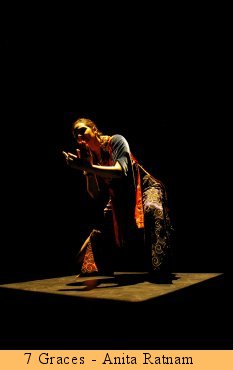 This
feeling was further enhanced when I saw the choreographic works of inDance
company of Hari Krishnan. Anita Ratnam in collaboration with Hari Krishnan
presented a totally reworked version of '7 Graces,' a solo multi-media
work dealing with Buddhist Goddess Tara in a modern context. After 40 performances
in 3 continents of the work in its original 51 minute version and many
abbreviations, '7 Graces' has achieved a finely honed meditative sheen.
Right from the pre-set glimpse of a bronzed head of the Buddha, with
a teardrop from his left eye from which Tara was born, the visual design
conceived by Rex, the house music of chanting filled the auditorium with
serene atmosphere completely different from the other evenings of the festival.
When the curtain opened with Anita standing still in a resplendent
robed costume, to her slow movement, the music emanating, as it were
from the monasteries, the different colours projected on the screen, the
colourful squares on the floor, the transition from slow Butoh like movements
to her signature Bharatanatyam, the intelligent covering of the space,
Tara's ritualistic movements, minimal abhinaya element and the final vision
when Anita bursts forth into singing, '7 Graces' stood out for its imaginative
choreography, concept and mature performance. The multi-media projection
and presentation had split-second precision with Anita complementing the
colour and mood changes to perfection. The choreographer's note helped
gaining entry point into Tara's many manifestations, each in specific
hues. The abstraction as achieved in number 7, viz., Black, Yellow,
Red, Blue, Green, White and one unseen through colour bars, the reference
to seven chakras of the subtle body as found in Indic religions, the work
resonated with 7 segments, 7 fluid kinetic languages in dance vocabulary,
7 soundscapes and Tibetan prayers and blessing in 7 colours. Anita's elegant
stage presence and resplendent dancing revealed the level of internalization
that this signature solo work has achieved over the past 4 years. Video
editing by Boyd Bonitzke and musical score using works of several musicians
including Subhasree Ramachandran, Anil Srinivasan, KSR Anirudha and Thudumbu
drums by D Prakash/Anand Sami, lighting by Arun Srinivasan indicated that
such collaborations enrich the landscape of contemporary choreography in
Indian dance with intelligence and honest rigour. This
feeling was further enhanced when I saw the choreographic works of inDance
company of Hari Krishnan. Anita Ratnam in collaboration with Hari Krishnan
presented a totally reworked version of '7 Graces,' a solo multi-media
work dealing with Buddhist Goddess Tara in a modern context. After 40 performances
in 3 continents of the work in its original 51 minute version and many
abbreviations, '7 Graces' has achieved a finely honed meditative sheen.
Right from the pre-set glimpse of a bronzed head of the Buddha, with
a teardrop from his left eye from which Tara was born, the visual design
conceived by Rex, the house music of chanting filled the auditorium with
serene atmosphere completely different from the other evenings of the festival.
When the curtain opened with Anita standing still in a resplendent
robed costume, to her slow movement, the music emanating, as it were
from the monasteries, the different colours projected on the screen, the
colourful squares on the floor, the transition from slow Butoh like movements
to her signature Bharatanatyam, the intelligent covering of the space,
Tara's ritualistic movements, minimal abhinaya element and the final vision
when Anita bursts forth into singing, '7 Graces' stood out for its imaginative
choreography, concept and mature performance. The multi-media projection
and presentation had split-second precision with Anita complementing the
colour and mood changes to perfection. The choreographer's note helped
gaining entry point into Tara's many manifestations, each in specific
hues. The abstraction as achieved in number 7, viz., Black, Yellow,
Red, Blue, Green, White and one unseen through colour bars, the reference
to seven chakras of the subtle body as found in Indic religions, the work
resonated with 7 segments, 7 fluid kinetic languages in dance vocabulary,
7 soundscapes and Tibetan prayers and blessing in 7 colours. Anita's elegant
stage presence and resplendent dancing revealed the level of internalization
that this signature solo work has achieved over the past 4 years. Video
editing by Boyd Bonitzke and musical score using works of several musicians
including Subhasree Ramachandran, Anil Srinivasan, KSR Anirudha and Thudumbu
drums by D Prakash/Anand Sami, lighting by Arun Srinivasan indicated that
such collaborations enrich the landscape of contemporary choreography in
Indian dance with intelligence and honest rigour.
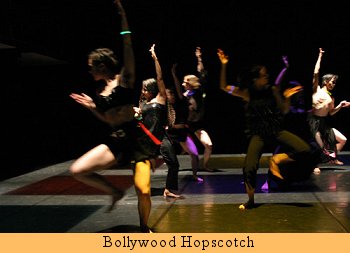 Anita's
dramatic solo was followed by 'Bollywood Hopscotch' choreographed by Hari
Kishnan with his inDance company dancers Nalin Bisnath, Shobana Raveendran,
Masumi Sato, Vinod Shankar and Emily Watts. From the word go, with full
screen size projection of excerpt from Sanjay Leela Bhansali's film Devadas,
purposely converted into Black and White, the tone was set. The elements
of exaggeration and humour were established at once. And the satire was
conveyed with lot of fun. Juxtaposing Bharatanatyam movements to the screenings
of excerpts of popular films, with body language transforming from Bharatanatyam's
architectonic quality to the hybrid quality of the films, the hero and
heroine running round the trees, the dancers raising their arms and turning
into trees in Bharatanatyam dance vocabulary, the lovers longingly looking
at each other from distance - it was pure fun. In particular, excerpt of
a popular Tamil film hero MG Ramachandran and the shootout sequence were
hilarious. The audience cheered instantly. Hari Krishnan's response to
the exaggeration and melodrama which are inevitable part of Indian cinema,
by juxtaposing with Bharatanatyam was highly enjoyable. The subversive
quality of the short choreography also included a flash of the famous cinematic
'jhatak' of the Bharatanatyam 'pushpanjali.' Add to it the high technical
quality of lights, costumes, flawless video projection, sound quality,
precision and very high standard of dancing, gesticulations... the audience
was applauding every moment in a mood reminiscent of the finale "Jaya Ho"
of the Hollywood blockbuster 'Slumdog Millionaire.' Anita's
dramatic solo was followed by 'Bollywood Hopscotch' choreographed by Hari
Kishnan with his inDance company dancers Nalin Bisnath, Shobana Raveendran,
Masumi Sato, Vinod Shankar and Emily Watts. From the word go, with full
screen size projection of excerpt from Sanjay Leela Bhansali's film Devadas,
purposely converted into Black and White, the tone was set. The elements
of exaggeration and humour were established at once. And the satire was
conveyed with lot of fun. Juxtaposing Bharatanatyam movements to the screenings
of excerpts of popular films, with body language transforming from Bharatanatyam's
architectonic quality to the hybrid quality of the films, the hero and
heroine running round the trees, the dancers raising their arms and turning
into trees in Bharatanatyam dance vocabulary, the lovers longingly looking
at each other from distance - it was pure fun. In particular, excerpt of
a popular Tamil film hero MG Ramachandran and the shootout sequence were
hilarious. The audience cheered instantly. Hari Krishnan's response to
the exaggeration and melodrama which are inevitable part of Indian cinema,
by juxtaposing with Bharatanatyam was highly enjoyable. The subversive
quality of the short choreography also included a flash of the famous cinematic
'jhatak' of the Bharatanatyam 'pushpanjali.' Add to it the high technical
quality of lights, costumes, flawless video projection, sound quality,
precision and very high standard of dancing, gesticulations... the audience
was applauding every moment in a mood reminiscent of the finale "Jaya Ho"
of the Hollywood blockbuster 'Slumdog Millionaire.'
I am reminded
of Arundhathi Subramaniam's comments on dance in films: 'Cultural meteorologists
may keep predicting the apocalypse; purists may still dismiss it as mere
"running and dancing around trees." But dance in cinema in India continues
to cavort on its own whimsical path, blithely irreverent of dire predictions,
and never failing to attract its mobs of enthralled viewers, as much today
as ever before.' Hari Krishnan, who is a rising star in the world of contemporary
South Asian dance, showed what an intelligent and judicious blending of
Bharatanatyam and hybrid movements can achieve in today's globalised world.
 Shunya
Photo:
Manpreet Sokhi
Shunya
Photo:
Manpreet Sokhi
|
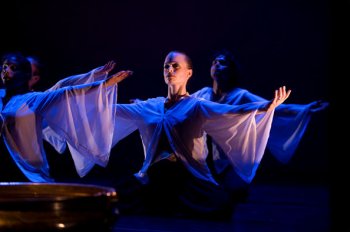 Shunya
Photo:
Manpreet Sokhi
Shunya
Photo:
Manpreet Sokhi
|
'Shunya' choreographed
by Lata Pada for Sampradaya Dance Creations was an apt finale to this festival.
Exploring the elusive symbol zero – shunya - in its mathematical, philosophical
and spiritual planes, point and counter-point, void and infinity, Ying
and Yang, metaphors that frame shunya in multiple cultural streams, as
the choreographer says in her note, the work explores two dance forms:
Kathak and Bharatanatyam. With her company dancers and several guest dancers
from India and the UK, the images come through cascading upon one
another, to the hauntingly melodious voice of Egyptian singer Maryem Hassan
Tollar (she has sung "maiya maiya" for A R Rahman in the film 'Guru'),
and music by Bangalore based musician Praveen D Rao. In Kathak, Arjun Mishra's
son Anuj Mishra draws immediate attention with his razor sharp movements,
brilliant footwork and high power execution of Kathak along with Aakash
Odedra. Other dancers Johanna Anthuber, Reshmi Chetram, Shruti Javali,
Aarti Joseph, Atri Nundy, performed in a manner which was just brilliant.
The final sequence with Sufi like whirlings was hypnotic. As observed earlier,
there has been a shift in the thematic content of contemporary choreography
in Indian dance. Gone are those themes of nayika and nayaka pining for
each other, in separation and repeating ad nauseum sentiments with
which few can relate. Shunya is a benchmark in Sampradaya's repertoire.
Since the opening is with the Sanskrit shloka 'Purnasya, purnamadaya...'
it would help the presentation to have it sung by an Indian vocalist in
place of Maryem, as the Sanskrit pronunciations by her jarred. Praveen
D Rao would do well to replace it in order to enhance the concept.
The festival
achieved what its agenda was: to see recent developments in contemporary
choreography in Indian dance, both within India and in Canada. If there
were two or three works which did not meet the aim of the conference, one
just ignored it, as they sunk without a trace. The program book brought
out, as in the past, has the customary finesse with detailed biographies
of the organizers and participants, meticulously edited by Dr. Rasesh Thakkar.
Since the video recordings have been made for documentation, it would serve
a great purpose if DVDs are made at the earliest, and are also accessible,
so that young generation and scholars can have access to these choreographic
works. Despite several hurdles, limitations, inclement weather, and unforeseen
problems, both Kalanidhi Fine Arts of Canada and Menaka Thakkar Dance Company,
with two sisters Sudha Khandwani and Menaka Thakkar at the helm of affairs
pulled off a hat trick!! 1993, 2007 and now the final edition. Bravo! Well
done Thakkars!
 Dr.
Sunil Kothari, dance historian, scholar, author, is a renowned dance critic,
having written for The Times of India group of publications for more than
40 years. He is a regular contributor to Dance Magazine, New York. Dr.
Kothari is a globetrotter, attending several national, international dance
conferences and dance festivals. He has to his credit more than 14 definitive
works on Indian classical dance forms. Kothari was a Fulbright Professor
and has taught at the Dance Department, New York University; has lectured
at several Universities in USA, UK, France, Australia, Indonesia and Japan.
He has been Vice President of World Dance Alliance Asia Pacific (2000-2008)
and is Vice President of World Dance Alliance Asia Pacific India chapter,
based in New Delhi. A regular contributor to www.narthaki.com, Dr Kothari
is honored by the President of India with the civil honor of Padma Shri
and Sangeet Natak Akademi award. Dr.
Sunil Kothari, dance historian, scholar, author, is a renowned dance critic,
having written for The Times of India group of publications for more than
40 years. He is a regular contributor to Dance Magazine, New York. Dr.
Kothari is a globetrotter, attending several national, international dance
conferences and dance festivals. He has to his credit more than 14 definitive
works on Indian classical dance forms. Kothari was a Fulbright Professor
and has taught at the Dance Department, New York University; has lectured
at several Universities in USA, UK, France, Australia, Indonesia and Japan.
He has been Vice President of World Dance Alliance Asia Pacific (2000-2008)
and is Vice President of World Dance Alliance Asia Pacific India chapter,
based in New Delhi. A regular contributor to www.narthaki.com, Dr Kothari
is honored by the President of India with the civil honor of Padma Shri
and Sangeet Natak Akademi award.
|

